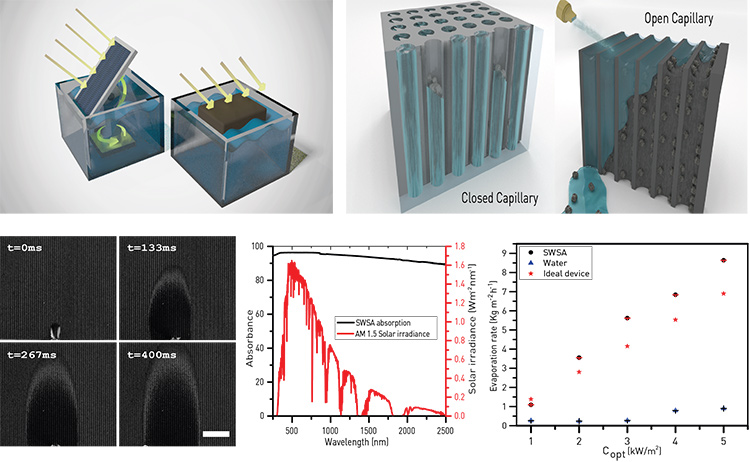 Top: Comparison of solar-tracked and flat evaporators (left) and of closed- versus open-microcapillary architectures. Bottom: Water-wicking dynamics at vertically mounted SWSA surface (left); SWSA absorbance and AM1.5 solar irradiance (center); and evaporation rates from the SWSA surface, an ideal device, and bulk water at different optical concentrations (right).
Top: Comparison of solar-tracked and flat evaporators (left) and of closed- versus open-microcapillary architectures. Bottom: Water-wicking dynamics at vertically mounted SWSA surface (left); SWSA absorbance and AM1.5 solar irradiance (center); and evaporation rates from the SWSA surface, an ideal device, and bulk water at different optical concentrations (right).
The combined effects of climate change, population increase and inadequate wastewater management have fueled a global water crisis. Wastewater recycling could be part of an environmentally feasible solution. In a recent work, we made a push toward that end, introducing a super-wicking, super-light-absorbing (SWSA) solar trackable panel for water sanitation.1
As it does with natural rain, solar energy can make wastewater drinkable. Traditional solar water-evaporation systems, however, suffer from severe thermal losses. Recently, an interfacial evaporation approach was developed, whereby solar-thermal heat generation and water evaporation occur at the same surface.2 However, such evaporators require a solar absorber with a wicking surface. Most previously developed solar absorber surfaces, however, are geometrically constrained by their out-of-plane and closed microcapillary architectures.2,3 That means that, to wick water, these evaporators must float on the water surface horizontally, and are thus unable to track the sun to optimize available solar irradiance.3 As a result, the efficiency of these evaporators significantly decreases when the sun is at larger zenith angles.
In the system we developed,1 a shiny piece of aluminum is turned pitch black and made superwicking through femtosecond laser processing.4 The resulting SWSA surface has, on average, around 97% absorption, and water runs uphill on the vertically mounted surface with high speed. Moreover, the interaction of water molecules with the surface changes its intermolecular bonding, resulting in a significant reduction in the enthalpy of vaporization.
Combining all of these features, we demonstrated high-efficiency solar-thermal generation of water vapor, with an evaporation rate exceeding that of an ideal device operating at 100% efficiency. In contrast to most previous, closed-microcapillary-based absorbers, our SWSA surface has an array of open microcapillaries parallel to the surface that supports a high rate of water transport on the panel mounted at any angle. The SWSA surface can thus be integrated with commercial trackable solar-thermal technologies to increase the total available solar flux for efficient vapor generation. We also demonstrated a bifacial SWSA panel that had an efficiency 150% greater than a single-sided SWSA.
Because of its open-capillary architecture, the SWSA surface can be easily cleaned and reused, requiring low maintenance. Our experiments showed that the SWSA-based device can be used to purify water from a range of contaminants, with contaminant levels in the purified water well below WHO and EPA standards for safe, drinkable water.
Researchers
Subhash C. Singh, Mohamed ElKabbash, Zilong Li, Xiaohan Li, Bhabesh Regmi, Matthew Madsen, Sohail A. Jalil, Zhibing Zhan, Jihua Zhang and Chunlei Guo, The Institute of Optics, University of Rochester, Rochester, NY, USA
References
1. S.C. Singh et al. Nat. Sustain. 3, 938 (2020).
2. P. Tao et al. Nat. Energy 3, 1031 (2018).
3. L. Zhou et al. Nat. Photon. 10, 393 (2016).
4. A.Y. Vorobyev and C. Guo. Appl. Phys. Lett. 94, 224102 (2009).
